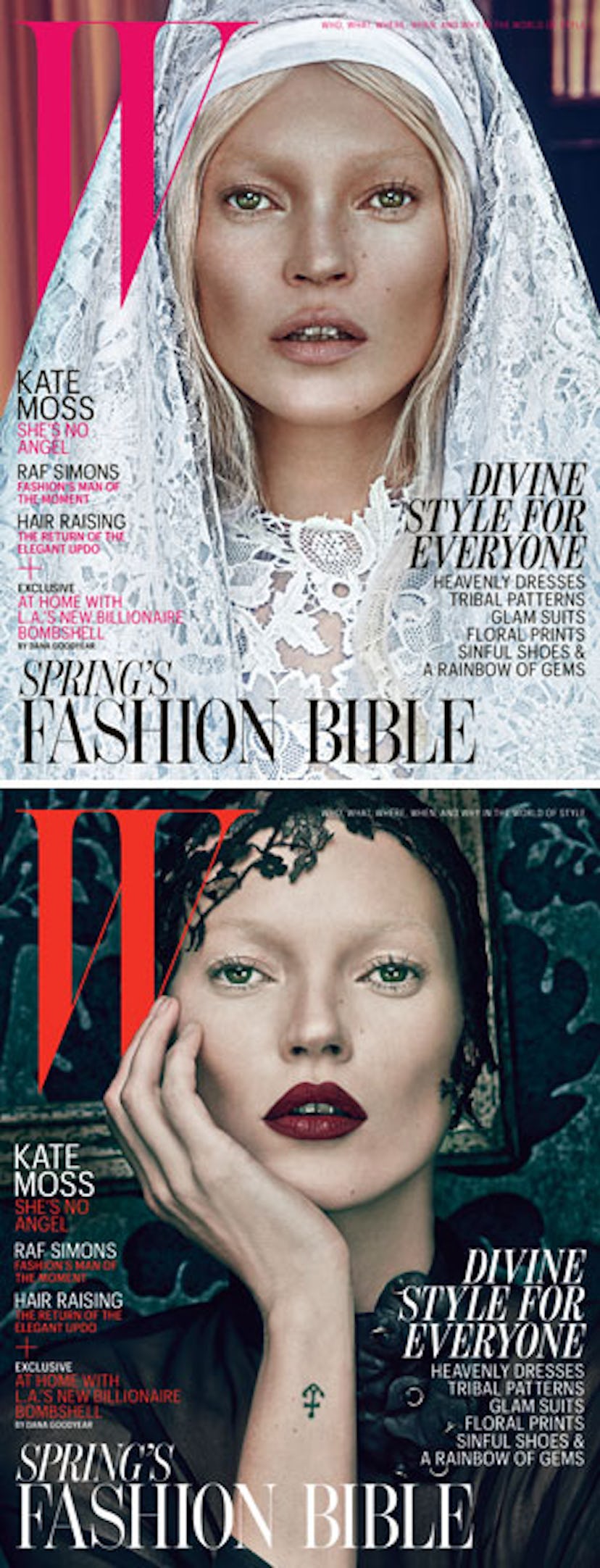When I pore over these wonderful images of the model, designer, and eternal waif Kate Moss, firefly thoughts flit in and out of the dark halls of my mind. I think first of Dorian Gray in Oscar Wilde’s amorality tale, who looks upon the portrait of himself in the fullest fruition of youth and wishes that it would age in his stead. Kate Moss seems to have always been with us—and to have always been as she is. Yet the truth is that she’s 38, twice married, and the mother of a 9-year-old girl. Her life has been a slalom through the toxicities of fame and success.
I look back to photos of Moss at the outset of her career, and I see the full and terrifying extent of her juvenescence: how much younger she seemed than she actually was. At 19 the revered and reviled face of “heroin chic,” Moss appeared to be in her Lolita teens. In her early 20s, she had the dégagé pout of a girl who has the right to vote but wouldn’t enter a polling booth unless you dropped it over her head. In catwalk footage from later on, Moss’s face had become streamlined, grown more feline, so that when emulating the swivel-hipped stride of her towering colleagues, she powered along the runway like a gilded hood ornament: inescapably British, the Rolls-Royce Spirit of Ecstasy gene-spliced—perhaps by some model-agent Dr. Moreau—with the iconic Jaguar. kate moss
Jil Sander’s cotton dress. Ashley Lloyd headpiece; Cornelia James gloves.
Moss has aged and continues to age—not gracefully, for she’s a suburban hellion from the outer limits of Cockneydom, but beguilingly. The images seen here delight in the platinum and pearliness of her slightly skew-whiff teeth. I lose myself in the cold reactor shutdown of her brown-to-black eyes. As for that ever feted bone structure? Well, what to do but wax poetic about that perfect geometry: Moss’s mouth no rosebud but a crushed carnation, her cheekbones somehow performing the alien accomplishment of curving down to below its petals.
Dark Moss and Light Moss. Bad Kate and Good Little Katie—simple dichotomizing is not what this dyad deserves. I look at the pictures of Moss dressed in black and think perhaps they’re of a great beauty meditating upon her own inner ugliness. I try to divine the precise symbolism of the tattoo on her wrist: Is it piratical anchor or Coptic cross or some strange merging of the two? I think of Baudelairean decadence, and I’m hammered back into Dorian’s gilt frame.
But then the images of Moss in white are hardly a counterpoint to the ones where she’s in black: The lacy swathing is too opulent, the blonde hair is too blonde, the skin has both the pallor of an ice age and the sun’s queasy burnish. Moss, neither the most adroit of catwalk queens nor a fluid component of moving pictures, has always excelled at presenting herself in such static and iconic formats.
In the past few years, with scandal heaped upon bathos, her once legendary media froideur—no interviews, no comments—has been fractured in ways so prosaic that far from shattering her visual image, it has left it mysteriously shellacked. With each dull revelation, the glaze on those features becomes thicker and her essential self becomes even more enigmatic. She remains like a great silent-screen heroine who’s animated and reanimated and then reanimated again by the fizzing jolt of the kliegs. Long may it continue.
